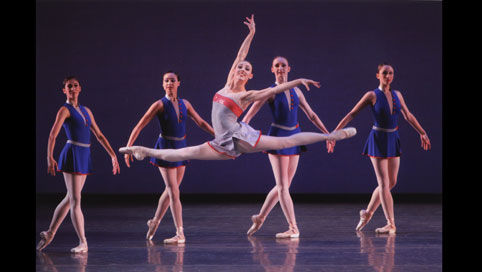NEW COMBINATIONS is a program of three stylistically similar ballets, one just premiered, another that was new last fall, and a third dating from 2000. They work remarkably well in juxtaposition, with their emphasis on historical allusion and reconsideration, a marked sensitivity to the interaction of color and choreography, and a deep appropriateness for a company, the New York City Ballet, trained in the techniques of physical precision and geometric abstraction. The unfolding of the three works on Sunday afternoon was like the opening of the leaves of a portfolio from which fluttered both engaging sketches and full-blown artworks.
The centerpiece, both literally and by implication, was the work that had premiered just a few days earlier, ‘Rōdē,ō: Four Dance Episodes, choreographed by Justin Peck in allusion to one of the signature ballets of the American canon, Agnes de Mille’s Rodeo. The fact that it is danced to Aaron Copland’s symphonic recasting of his original score takes the edge off what might otherwise have been interpreted as a risky, if not presumptuous, reworking of a classic. But it is impossible not to compare the two, if one knows the original, and the result is, at a minimum, a lively dialogue between past and present.
The original was subtitled “Courting at Burnt Ranch,” signaling the central theme, which is basically a mating dance played out in the quintessentially masculine, and ostensibly heterosexual, space of the North American frontier. Rodeo was essentially about the incursion of the feminine into a culture of male homo-sociality, and the inherent tension between the men maintaining a dominant space while also desiring the presence of women. The underlying seriousness of this theme, along with the poetics of place of which Copland is a master, has made de Mille’s vision, which is light-heartedly gender bending, both enduring and feministic.
Peck’s ‘Rōdē,ō eliminates all of the women except one; it is fifteen men plus Sara Mearns; elides the Wild West setting; and is not particularly heterosexual in its underlying assumptions. The men seem neither threatened by nor in competition for the single woman in their midst; it is also the case that the sense of place is left deliberately vague. The music is suggestive of landscapes, but the set is completely neutral, and the costumes, which include leg warmers and exposed biceps, suggest a gym or sporting milieu. Mearns, a remarkably athletic dancer whose every leg muscle ripples in her pas de deux with Amar Ramasar, seems more admired than desired by the all-male-but-her cast. It is not clear to me what is being said, exactly, by Peck’s reconfiguration of sex and gender in respect to our memories of the de Mille. But ‘Rōdē,ō is engrossing as choreography and thought-provoking in the allusions it cannot help but make.
It follows, on the current program, Alexei Ratmansky‘s 2014 Pictures at an Exhibition, to the Mussorgsky played on a single piano, and precedes Christopher Wheeldon‘s Mercurial Manoeuvres, from 2000, which is both seamless and exquisite.
The Ramansky is danced before a backdrop, in Wendall K. Harrison’s production design, of Kandinsky images in lieu of the pictures represented by Mussorgsky’s tone poem. The colors are beautiful and the patterns precise both in the staging and the images; the lightly feathering costumes are like brushstrokes on a canvas. There are solos, precise duets, full company promenades, fantastic abstractions of color and form. It is less dramatic than I might have expected, given my prior knowledge of the music, and it is not clear to me whether Cameron Grant‘s interpretation on the piano is deliberately modernist in its lack of lushness, to bring it in line with the Kandinsky and abstract choreography, or if it could be legitimately faulted for its lack of emotion. It does, in any case, accompany the dance rather than overwhelm it, and the ballet as a whole is austerely beautiful.
Mercurial Manoeuvres is, on the other hand, unflagging in its sweep and vivacity. Its colors are bold, the stage awash in red and blue, with the inimitable Tiler Peck a spot of grey in their midst, propelled by Andrews Sill‘s vibrant rendition of the Shostakovich score (Concerto in C minor for Piano, Trumpet and String Orchestra, Op. 35). Wheeldon’s dancers peel off in great strips of coordinated movement, caught up in swatches of sound and envelopes of color. Peck, who like so many of the NYCB’s female principals pairs a persona of offstage ordinariness with an ethos of onstage brilliance, dances the piece with astounding ease and softness, while still going en pointe with the surety of iron attaching itself to a magnet. Something in this ballet seems made for her, or she for it, and Jared Angle, with whom she partners, is there when needed to make it happen. They are in superb unison, and execute without flaw the motif – present in each of the NEW COMBINATIONS – of motion suddenly arrested, the stop that startles but doesn’t jar, a stillness abrupt and airborne but never heavy.
For information on the New York City Ballet, click here. “Pictures at an Exhibition” will be presented on several dates from April 20-30, 2016: info.
